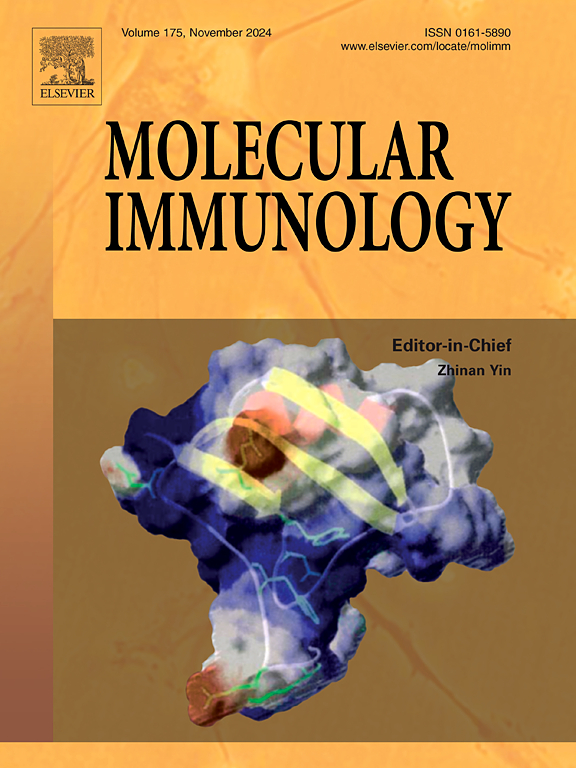The mechanism of SMAD4/ERK pathway in regulating Th17/Treg cell differentiation leading to olfactory dysfunction in chronic rhinosinusitis
IF 3
3区 医学
Q2 BIOCHEMISTRY & MOLECULAR BIOLOGY
引用次数: 0
Abstract
Background
Chronic rhinosinusitis (CRS) is characterized by a high recurrence rate within five years post-surgery, posing a persistent challenge for otolaryngologists globally. Recent research has underscored the pivotal role of the Th17/Treg cell balance in the pathogenesis of CRS. This study aims to investigate the alterations in the Th17/Treg cell balance in CRS and elucidate the underlying molecular mechanisms.
Methods
CRS model was established to assess the levels of inflammatory cytokines, olfactory marker protein expression, SMAD4 expression, and ERK1/2 phosphorylation. We then overexpressed SMAD4 or treated CRS mice with ERK1/2 inhibitors, measuring the impact on Th17/Treg marker expression. Moreover, the influence of the SMAD4/ERK signaling axis on the Th17/Treg balance within the CD4 + T cell population was investigated.
Results
CRS mice exhibited significantly reduced olfactory marker protein and SMAD4 expression, alongside increased ERK1/2 phosphorylation. Histological analysis revealed an increased infiltration of eosinophils. Of particular note, the expression of Treg markers was markedly decreased, while Th17 marker expression exhibited a corresponding increase, suggesting a potential shift in the Th17/Treg balance. Interventions involving SMAD4 overexpression or ERK1/2 inhibition led to a reduction in eosinophil infiltration and successfully reversed the aberrant expression patterns of the aforementioned markers. Furthermore, SMAD4 knockdown resulted in a decreased proportion of Treg cells and an increased proportion of Th17 cells. This alteration in the Th17/Treg balance was effectively counteracted by ERK inhibitor.
Conclusions
The deletion of SMAD4 regulates the differentiation of Th17/Treg cells via ERK1/2 phosphorylation, thereby exacerbating the olfactory dysfunction of CRS.
SMAD4/ERK通路调控Th17/Treg细胞分化导致慢性鼻窦炎嗅觉功能障碍的机制
慢性鼻窦炎(CRS)的特点是术后5年内复发率高,对全球耳鼻喉科医生构成了持续的挑战。最近的研究强调了Th17/Treg细胞平衡在CRS发病机制中的关键作用。本研究旨在探讨CRS中Th17/Treg细胞平衡的改变,并阐明其分子机制。方法建立scrs模型,评估炎症因子、嗅觉标志蛋白表达、SMAD4表达和ERK1/2磷酸化水平。然后,我们过表达SMAD4或用ERK1/2抑制剂治疗CRS小鼠,测量对Th17/Treg标记物表达的影响。此外,我们还研究了SMAD4/ERK信号轴对CD4 + T细胞群中Th17/Treg平衡的影响。结果scrs小鼠嗅觉标记蛋白和SMAD4表达显著降低,ERK1/2磷酸化水平升高。组织学分析显示嗜酸性粒细胞浸润增加。特别值得注意的是,Treg标记物的表达明显下降,而Th17标记物的表达则相应增加,这表明Th17/Treg平衡可能发生了变化。涉及SMAD4过表达或ERK1/2抑制的干预导致嗜酸性粒细胞浸润减少,并成功逆转上述标记物的异常表达模式。此外,SMAD4敲除导致Treg细胞比例下降,Th17细胞比例增加。这种Th17/Treg平衡的改变被ERK抑制剂有效地抵消了。结论SMAD4缺失通过ERK1/2磷酸化调控Th17/Treg细胞的分化,从而加重CRS的嗅觉功能障碍。
本文章由计算机程序翻译,如有差异,请以英文原文为准。
求助全文
约1分钟内获得全文
求助全文
来源期刊

Molecular immunology
医学-免疫学
CiteScore
6.90
自引率
2.80%
发文量
324
审稿时长
50 days
期刊介绍:
Molecular Immunology publishes original articles, reviews and commentaries on all areas of immunology, with a particular focus on description of cellular, biochemical or genetic mechanisms underlying immunological phenomena. Studies on all model organisms, from invertebrates to humans, are suitable. Examples include, but are not restricted to:
Infection, autoimmunity, transplantation, immunodeficiencies, inflammation and tumor immunology
Mechanisms of induction, regulation and termination of innate and adaptive immunity
Intercellular communication, cooperation and regulation
Intracellular mechanisms of immunity (endocytosis, protein trafficking, pathogen recognition, antigen presentation, etc)
Mechanisms of action of the cells and molecules of the immune system
Structural analysis
Development of the immune system
Comparative immunology and evolution of the immune system
"Omics" studies and bioinformatics
Vaccines, biotechnology and therapeutic manipulation of the immune system (therapeutic antibodies, cytokines, cellular therapies, etc)
Technical developments.
 求助内容:
求助内容: 应助结果提醒方式:
应助结果提醒方式:


